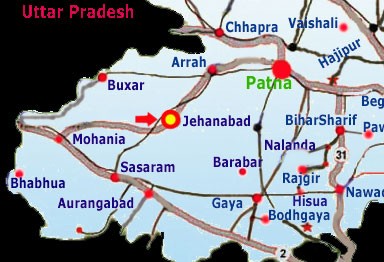
Introduction
Jehanabad district was carved out of old Gaya district on August 1, 1986. Earlier, it had been a subdivision of the Gaya district since 1872. The main objective behind the creation of this district was to accelerate the pace of development to tackle the problem of extremism, poverty, unemployment
The city of Jehanabad, which is the district HQ is situated on the confluence of the rivers Dardha and Jamune. The total land of the district is plain. It is crisscrossed by a number of river and rivulets, all seasonal, such as Galgu, Morhar, Dardha, lamune, Baldeyia and Ganghar.
legends, Hindu as well as Buddhist, take down the history of jehanabad to a period of hoary antiquity. The earliest of the archeological remains in the district are to be found in the Barabar and Nagarjuni hills. The description of jlehanabad is also found in the famous book ‘Aain-e-Akbari’.
Places of Interest
WHAT TO LOOK FOR
Barabar
Situated at a distance of 11 km from the Makhdumpur block HQ Barabar can be
called a tourist’s paradise. Barabar, connected by a motorable road, consists
of a group of hills with distinct peaks. The most conspicuous are the peaks
known as Murali, Sandagiri and Siddheshwar. These hills are noted for the
world-famous Seven Caves. For sheer panoramic grandeur and rugged natural
beauty, very few places in the old Gaya district can be compared to the
northern portion of the Barabar hills. There’s an ancient temple of Siddheshwar
nath, which from an inscription in one of the neighbouring caves is known to
belong to the sixth or seventh century. This temple attracted the attention of
pilgrims even before the advent of Buddhism.
Towards the south of Siddheshwar nath Temple at its foot lies a small basin surrounded by hills with openings on the north-east and south-east where walls have been built. Towards the southern corner of the basin are two small sheets of water, which find an outlet under ground to the south-east and reappear in the sacred spring called ‘Patal Ganga’, where a bathing festival is held annually on Anant Chaturdashi.
The Barabar Caves are excavated in the hardest granite with infinite care and the interior surface of all of them contains high polish and is burnished like glass. Chinese traveller Xuanzang its visited this place and has given detailed descriptions of the place in his book. However, the credit for unravelling the charm and appeal of the Barabar hills goes to celebrated British author E M Forster. Forster’s ‘A Passage to India’ is replete with references to the Barabar hills though the name has been changed to Marabar.
Taking into consideration the immense tourism potential, historicity and religious significance of Barabar hills, the Bihar tourism department in association with the district administration has renovated the place giving it an entirely new look.
FACILITIES AT BARABAR
Stairways to the Siddheshwar nath Temple a top the hill
Tourist bungalow at ‘Patal Ganga’
Cafeteria
Piped water facilities
Nagarjuni Museum
Rural Marketing Complex
Police outpost
Telephone booths
Solar and electric lights
Dharaut
About 10 km north-west of Barabar hills, Dharaut has been identified as the site of the Buddhist monastery of Gunamati. At the foot of the Kunwa hill is a large tank known as Chandpokhar or Chandrapokhar. The name of the tank perpetuates the legend that it was excavated by Raja Chandra Sen. Two modern temples at its north-eastern corner once contained a large collection of ancient statues.
Dabthu
Six km east of Hulasganj in the district, Dabthu is chiefly known for its finely-carved images and ruins of temples. In the remains of ancient shrines, one can still see images of deities mutilated and decayed by ravages of time.
Ghejan
Situated in the Tatani-Faridpur block of the district and about 19 km away from jehanabad on the Shakmabad-Ghyan road, this place came light after the Gupta-period stone statues were excavated here. A huge statue of Lord Buddha has been on display in the village.
Kako
Kako is one of the blocks of this district situated at a distance of 10 km from the district HQ. There is a temple in the north-east of the village which has an ancient statue of sungod. There is also a mausoleum of great woman Sufi saint Hazrat Bibi Kamal. Bibi Kamal, aunt of Hazrat Makhdum Saheb of Biharsharif, is said to have been endowed with mystic and divine powers.
Ancient monuments have also been found in several other villages of the district like Bhelawar, Meerabigha, Amthua, Banwaria, Zaroo, Lat, Murgaon, Lari and Umta.
HOW TO REACH
By
Air:
Nearest
Airport
Jhanabad
is 55 km from Patna and 50 km from Gaya; that is, it is centrally located
between Patna and Gaya. It is linked by both road and rail routes. The
Patna-Gaya section of the East Central Railway, popularly known as the PG line,
passes through this district.
The Patna-Dobhi national highway also passes through this
district, connecting it with the Grand Trunk national highway in the Gaya
district. A number of buses ply between jehanabad and other towns of the state,
including Patna and Gaya
By
Rail:
Emergency,Contact
District Magistrate: 223001 (Res), 9431226100 (Mobile)
Superintendent of Police: 223110 (Res), 9431822976 (Mobile)
Town Police Station: 223017, 9431822258
Medical
Emergencies, Contact
District Sadar Hospital: 227794
Civil Surgeon: 9431071836
Dr Girijesh Kumar: 9431279908
Dr Leela Sinha: 223220
Dr K Rajan: 223366, 9431083321
Dr Qaisar Hussain: 9955430466
By Road:
Connected by good roads with all Indian cities.
Where to Stay:
Sriram Hotel, PG Road, Mobile: 9431256935
Shalimar Rest House, PG Road, Mobile: 9234541644
Taj Rest House, PG Road, Mobile: 9934610150
Muralidhar Rest House, PG Road, Mobile: 9939912355
Balaji Rest House, Court area, Mobile: 9431280046
Local Transport:
Auto rickshaws, Cycle-rickshaws, tangas.
Tourist Season
October to March.
Clothing:
Light cotton in summer and woolen in winter (specially during November to
January).